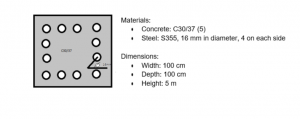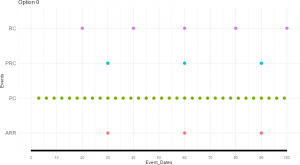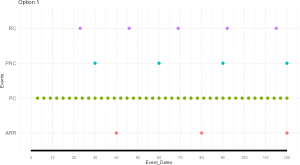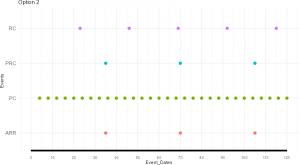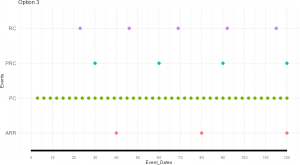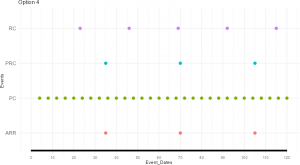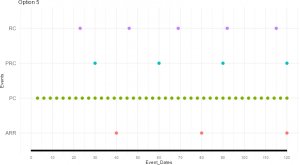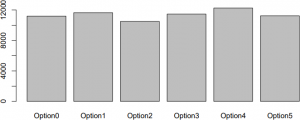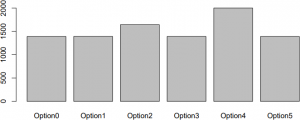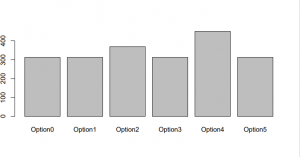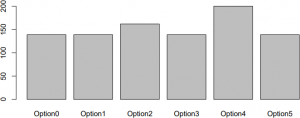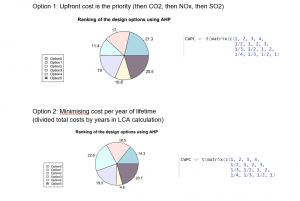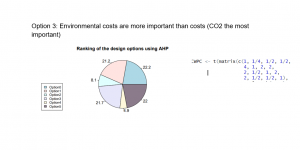Introduction and Design Options-
This second task will proceed to investigate the life cycle of a pillar/column out of reinforced concrete. The design options for a reinforced column are provided in the table below-
| Design option | Concrete | Pillar side length | Steel type | Rebar diameter | Rebar amount |
| Option 0 | C30/37 | 100 cm | S355 | 16 mm | 4 each side |
| Option 1 | C30/37 | 100 cm | S355 | 20 mm | 4 each side |
| Option 2 | C35/45 | 100 cm | S355 | 16 mm | 4 each side |
| Option 3 | C30/37 | 100 cm | S355 | 16 mm | 5 each side |
| Option 4 | C30/37 | 120 cm | S355 | 16 mm | 4 each side |
| Option 5 | C30/37 | 100 cm | S460 | 16 mm | 4 each side |
The parameters which are needed to roughly calculate the materials’ quantities are provided in the table below. A sketch of the reinforced column shows the, indicating the main materials and its dimensions
| Material | Parameters |
| Concrete | Width and height of the pillar |
| Steel | Amount and diameter of the chosen rebar types |
Goal and Scope of the LCA-
To discuss the scope and goal of the life cycle analysis of a reinforced concrete column, we need to provide some additional data as asset managers. The required information for the LCA is summarized as follows-
TotalLifespan = 100 years (1)
Goal: consider different modifications of a column that increase the lifespan and compare the environmental cost increases.
Scope: A1-A3 construction : CO2, NOX, SO2 and cost factors.
Maintenance Intervention strategies-
An asset manager needs to consider while maintaining the product and the different options. The boundaries of the analysis and argue for the reason for it. Also provide a sketch showing your timeline and the necessary
| Problems expected over the life time | Possible interventions |
| concrete cracking | Monitor length and width of cracks, fill in cracks if necessary |
| concrete surface deterioration | Monitor surface condition and exposure to environmental conditions. Apply a protective surface coating if necessary |
| concrete pieces falling out | Check rebar condition, fill in concrete |
| steel corrosion | Monitor rebar condition |
| steel breaking | Partial replacement |
-
Standard maintenance frequency:
RC Repair cracks (4, 8) – every 20 years (4)
PRC Partial replacement concrete (4, 8) – 30 years (6)
ARR Adding or replacing rebar (4, 8) – 30 years (6)
PC Protective coating (4, 8) – 3 years (7)
Specific lifetimes and maintenance frequencies for the modified parameter configurations could not be found. The assumed extended lifetime for the modified structures is 120 years – the upper range of lifetime range of bridge structures in many countries. (1) All of the modifications have limiting the cracks as their goal, which helps prolong the longevity of a building structure. Because of that the maintenance frequencies are estimated to change. In the case of bigger dimensions and higher concrete class I estimate the concrete repairs to be needed less often (RC – every 23 years, PRC and ARR every 35 years and PC every 4 years). In the case of more rebar, increased rebar diameter and higher rebar steel class not only ARR will be extended but resulting cracks are also limited due to more tensile strength (RC every 23 years, ARR and PRC every 40 years). The times are a rough estimate based on my professional experiences and studies. I estimated PRC and ARR time as the same, because usually if concrete coating is missing on a structure, rebar repairs are necessary and if rebar inside is rusted, concrete covering is partially destroyed or needs to be cut in order to repair the rebar.
Life cycle Inventory-
Steel S460 NOX and SO2 emissions are estimated as emissions of S355 + 15% (because the CO2 emissions have increased that much a similar increase is estimated). Unit weight of steel is estimated at 78,5 kN/m³ ( 7,85 t/m³). As the rebar volume is comparatively small it will not be subtracted from the volume of concrete – volume of concrete = width * length * height.
Quantities of materials needed for repairs and maintenance are negligible in comparison to quantities that are used in construction – sealing cracks demands a very small volume and even if the rebar is removed, replaced and sealed with concrete the amounts of materials used are very low compared to total volume (repairs usually on the outside of the column). But the amount of materials that need to be ordered cannot be that small – it is not possible to order 20 cm of rebar or 10g of cement. Because of that 2% of total volume of a column will be estimated for partial concrete and 5% for rebar replacement. For crack sealing the amount of materials is even lower and will not be considered further.
The area of the column is 20m² estimating a sealant will be used on the entire area (no area covered by water) and considering the technical specifications, price and efficiency of ghostshield siloxa-tek-8500 sealant one surface sealing will cost approximately 60 €. No appropriate data about the environmental costs of sealant could be found.
Life Cycle Analysis-
Cost estimates for different design options:
CO2 emissions for different design options:
NOx emissions for different design options:
SO2 emissions for different design options:
For the AHP analysis, the matrix values chosen are based on the results of the LCA calculation for Cost, CO2, NOx and SO2. Chosen matrices for the multi-criteria decision analysis:
Discussion of the results-
The costs were the primary factor of the analysis, as from my job experience until now they are the key factor when deciding between many design options. The results are very varied depending on the construction priorities. If the lowest possible upfront cost option is chosen, the option with an increased rebar class is in the second optimal place but extremely close to the cost of the option with the shortest predicted life span. If the costs per year of life time are to be minimised Option 2 was the most optimal – the option with an increased concrete class. Just after it was, again, the option with an increased steel class. When considering the usage time the option with the shortest life time did not get such a good score anymore. The third analysis was the most interesting for me – the environmentally conscious one. Its result was pretty much the same for Options 0, 1, 3 and 5 (Option 0: 100 years life time, Option 1: increased rebar diameter,Option 3: increased rebar amount, Option 5: increased rebar steel class). The options with increased concrete class and increased concrete volume turned out to be far less optimal with option 4 – increased concrete volume being by far the worst choice. After looking into this topic a couple of factors that have not been considered can influence the emissions even more in favour of steel – one of them that was not considered in the analysis is the recycling. Steel is highly recyclable, and recycled steel has a lower environmental impact than virgin steel. Concrete can also be recycled, but the process is more challenging and is usually downgraded in the process. I was surprised by such a big disparity in emissions between increasing concrete and rebar – it shows how much influence every structural engineer has on the environment; just by slightly increasing the concrete class or volume for safety or aesthetics the resulting environmental effect is already high when considering only 5 m³ of concrete.
When considering a structure with much more concrete and rebar the true impact of these decisions can be seen – and the potential of improving the world. Integrating the potential advantages of incorporating recycled materials into LCA could enrich the environmental perspective and possibly convince more engineers to pick the more environmentally conscious options. Presenting such a graph to stakeholders can help the awareness about the far-reaching consequences of design choices on both economic and environmental fronts.
Home Page | Maintenance Strategies | Life Cycle Analysis | Multi Objective Optimization
